European Neighbourhood Policy - East - statistics on trade in goods with the EU
Data extracted in January 2023.
Planned article update: April 2024.
Highlights
Azerbaijan has recorded an external trade balance surplus in every year 2011-2021. No other European Neighbourhood Policy-East country has had a trade surplus during the period 2016-2021.
Among the European Neighbourhood Policy-East countries reporting 2021 data, the EU accounted for 61 % of the total exports of Moldova, 22 % of Armenia’s exports and an estimated 17 % of those of Georgia.
2.0 % of all goods exported from the EU in 2021 were destined for the European Neighbourhood Policy-East countries, while 2.2 % of EU imports came from these countries.
ENP-East countries exports of goods to the EU, 2011-2021
This article is part of an online publication and presents information relating to recent developments for international trade in goods for five European Neighbourhood Policy-East (ENP-East) countries, namely, Armenia, Azerbaijan, Georgia, Moldova and Ukraine, in particular concerning their trade relations with the European Union (EU). Georgia, Moldova and Ukraine became also enlargement countries in 2022, the European Council giving the three a European perspective and granting Moldova and Ukraine candidate status on 23 June 2022. This article does not contain any data on Belarus as statistical cooperation with Belarus has been suspended as of March 2022.
Data shown for Georgia exclude the regions of Abkhazia and South Ossetia over which Georgia does not exercise control. The data managed by the National Bureau of Statistics of the Republic of Moldova does not include data from Transnistria over which the government of the Republic of Moldova does not exercise control. Since 2014, data for Ukraine generally exclude the illegally annexed Autonomous Republic of Crimea and the City of Sevastopol and the territories which are not under control of the Ukrainian government. The most recent data covers the year 2021, before Russian war of aggression against Ukraine. Data on Ukraine for the year 2021 is limited due to exemption under the martial law from mandatory data submission to the State Statistics Service of Ukraine, effective as of 3 March 2022.
The article highlights some of the key indicators for tracing developments in the international trade of the ENP-East region over the period 2011-2021, with information on exports, imports and the trade balance. It is followed by an examination of trade between ENP-East countries and the EU from the perspective of the ENP-East countries, using data reported by the ENP-East countries themselves. The subsequent parts of the analysis mirror this approach and look at trade flows to/from ENP-East countries from the perspective of the EU, using Eurostat data. There are differences in the values of trade reported by ENP-East countries and by EU Member States; more information on this phenomenon is provided in the data sources section. The article also presents an analysis of international trade between the regions by selected product groups (based on the standard international trade classification (SITC)).
Full article
Exports, imports and the trade balance
International trade statistics track the value and quantity of goods traded between countries. They are the official source of information on imports, exports and the trade balance, the difference between them. The data in Table 1 show the total exports, imports and the trade balance as a percentage of the GDP of the ENP-East countries and the EU. This shows the significance of international trade relative to the size of the economies concerned.
From at least 1970 until the global financial crisis in 2008, global trade increased as a proportion of GDP. Trade globalisation has levelled off since then [1]. Countries that are growing fast or are undergoing or recovering from economic difficulties may wish to run trade deficits, in which the value of imports is greater than that of exports. Countries that specialise in providing services to the rest of the world, such as tourism or business services, may also run consistent trade deficits, since services are not included in the statistics of exports and imports of goods. The balance of payments includes data on both trade in goods and in services.
Total trade, the sum of exports and imports (the average is sometimes quoted), as a percentage of GDP is a common measure of a country’s openness to world trade. Smaller countries tend to have higher levels of trade openness than larger ones, since there are fewer opportunities for buying and selling domestically produced goods. The relationship between trade openness and income (measured as GDP per capita) is more complicated, although low income countries generally have low trade openness.
The data in Table 1 show that Armenia’s exports and imports in 2011 were equivalent, respectively, to 11.6 % and 38.5 % of GDP. By 2021, Armenia’s exports had risen to 21.7 % of GDP, with imports down to 38.4 %. Hence, the trade deficit diminished from 26.9 % of GDP in 2011 to 16.7 % in 2021. The trade deficit had been as low as 14.1 % of GDP in 2016: imports were near their 2015 lows that year and subsequently grew again. The measure of openness to trade was 60.1 % of GDP in 2021, an increase of 10.0 percentage points over the period.
Azerbaijan, with its large export-oriented hydrocarbon sector, is the only ENP-East country to show a trade surplus. In 2011, the trade surplus was equal to 25.5 % of GDP, then fell to 6.6 % in 2015, before rising to 17.0 % in 2018, declining to 7.0 % in 2020 and rising again to 19.2 % in 2021. Exports have driven these trends. The low point during the period occurred in 2015, when exports were 24.0 % of GDP; the high point was in 2018, when exports equalled 41.4 % of GDP. Exports in 2021 were 40.7 % of GDP. Imports ranged from 12.2 % of GDP in 2014 to 28.4 % in 2019. The value for 2021 was 21.4 % of GDP. Exports plus imports rose by 7.0 percentage points over the period, leading to trade openness being measured at 62.1 % of GDP in 2021.
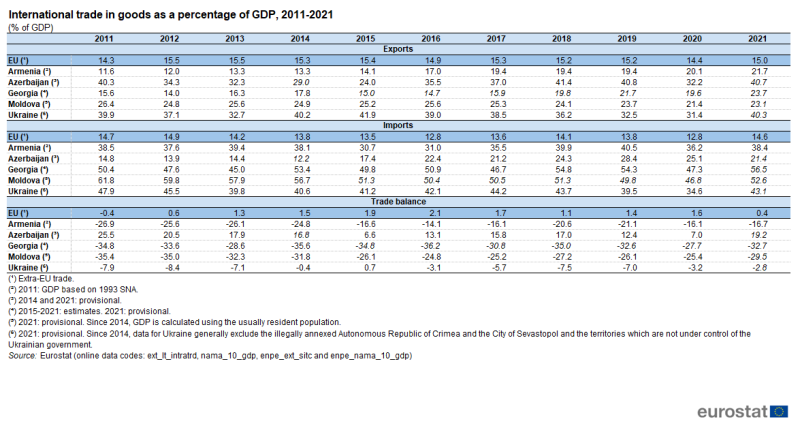
(% of GDP)
Source: Eurostat (ext_lt_intratrd), (nama_10_gdp), (enpe_ext_sitc) and (enpe_nama_10_gdp)
Georgia’s exports plus imports in 2021 equalled 80.2 % of GDP, an increase of 14.3 percentage points over the 2011 figure. This change was accounted for by an increase in both exports and imports over the period. At the same time, Georgia’s negative trade balance has been fairly consistent: it was in deficit in 2011 at 34.8 % of GDP and in 2021 at 32.7 %. The greatest value of the trade deficit was 36.2 % in 2016. Its minimum value was 27.7 % in 2020. Exports as a percentage of GDP have ranged from 14.0 % in 2012 to 23.7 % in 2021. Imports as a percentage of GDP were at their lowest in the period in 2013 at 45.0 % and their highest in 2021 at 56.5 %.
Moldova’s trade openness measure was 75.7 % of GDP in 2021, 12.5 percentage points less than 10 years earlier. This change was almost entirely due to a fall in imports as a proportion of GDP, which declined in particular from 2014 to 2015. Imports were at their lowest for the period in 2020 at 46.8 % of GDP, then recovered in 2021 to 52.6 %. Exports have accounted for a fairly consistent share of GDP: the lowest during the period was 21.4 % in 2020 and the highest 26.4 % in 2011. The trade balance improved from a deficit of 35.4 % of GDP in 2011 to one of 25.4 % in 2020 but then deteriorated to 29.5 % of GDP in 2021.
Ukraine’s aggregate trade was equal to 83.4 % of GDP in 2021. This result was a return to levels last seen during 2014-2017 but was still 4.4 percentage points lower than in 2011. A lower share of imports in GDP in 2021 than in 2011 was responsible, while the share of exports in GDP was virtually unchanged in 2021 from 10 years earlier. Imports as a share of GDP were highest for the period in 2011 at 47.9 % and were at the lowest for the period in 2020, at 34.6 % of GDP. In 2021, imports accounted for 43.1 % of GDP. Exports in 2011 were 39.9 % of GDP: the 2021 value was 40.3 %. The highest value during the 2011-2021 period was 41.9 % in 2015 and the lowest was 31.4 % of GDP in 2020. The country had a balance of trade deficit of 7.9 % of GDP in 2011, improving to 0.4 % in 2014 and being slightly positive in 2015 (0.7 %), before decreasing to a deficit of 7.5 % in 2018. There was an improvement in 2020 and 2021, when the deficit was 3.2 % and 2.8 %, respectively.
The statistics for the EU are shown for extra-EU trade only, treating the EU as a single trading entity. Its degree of trade openness, at 29.7 % of its GDP in 2021, is smaller than any of the ENP-East countries. This difference is due to its much larger economy.
The EU as a trading partner for the ENP-East countries
Figures 1 and 2 show the available data for ENP countries’ exports to and imports from the EU as a percentage of their total exports and imports over the period 2011-2021.
For Armenia, there was a clear trend of decline in the EU’s share of total exports and imports over 2011-2021. By the end of the period, the EU’s share of Armenia’s exports had dropped by 16.5 percentage points to 21.8 % and its share of Armenia’s imports by 6.3 percentage points to 17.4 %.
In Georgia, the share of exports to the EU fluctuated over the period 2011-2021, but ended 1.9 percentage points lower, at 16.9 %. In 2021, the share of imports was 4.9 percentage points lower than in 2011, at 22.9 %.
The EU’s share in Moldova’s exports grew from 2011 to 2021 by 16.8 percentage points to 61.0 %. The EU’s share of Moldova’s imports, at 43.8 % in 2021, was 1.7 percentage points higher than in 2011. Both EU export and import shares in Moldova were by far the highest among the reporting ENP-East countries. Moldova’s membership of the Central European Free Trade Agreement presumably contributed to this difference - see the ‘Context’ section below.
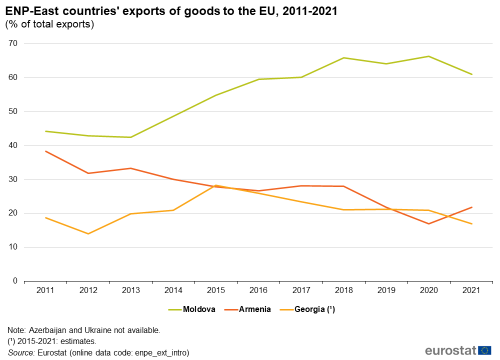
(% of total exports)
Source: Eurostat (enpe_ext_intro)
The share of the ENP-East countries' trade with the EU, relative to their GDP, is found by taking the share of exports and imports in GDP (Table 1) and multiplying it by the share of exports and imports to/from the EU in total trade (Figure 1 and Figure 2, respectively). For example, Armenia’s total exports in 2021 were equivalent to 21.7 % of GDP. Armenia’s exports to the EU in the same year accounted for 21.8 % of all trade. Multiplying these two percentage yields Armenia’s exports to the EU as share of GDP: in 2021, the result is 4.7 % of GDP. This calculation provides a measure of the relative importance to the ENP-East countries' economies of their trade with the EU.
As shown in the calculation above, Armenia’s exports to the EU in 2021 accounted for 4.7 % of its GDP, slightly higher than in 2011 (4.4 %). Its imports were equivalent to 6.7 % of GDP in 2021, a decline of 2.4 percentage points from 2011. Georgia’s exports to the EU accounted for 4.0 % of GDP in 2021, an increase of 1.1 percentage point over 2011. At 12.9 %, the share of its EU imports in GDP in 2021 was 1.1 percentage point lower than in 2011. Moldova’s exports to the EU as a percentage of its GDP were 14.1 % in 2021, an increase of over 2.4 percentage points over 2011. The corresponding figure for imports was 23.1 % in 2021, a decline of 2.9 percentage points from 2011.
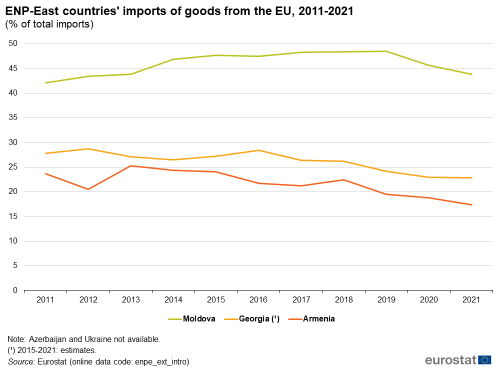
(% of total imports)
Source: Eurostat (enpe_ext_intro)
The ENP-East countries as trading partners for the EU
This section uses statistics compiled by Eurostat from data submitted by EU Member States. This source differs from most of this Statistics Explained article, which uses data provided to Eurostat by the ENP-East countries. See the Data Sources section below for more information.
Exports and imports of internationally traded goods to and from the ENP-East countries are shown as a percentage of the EU’s total external exports and imports in Figure 3. They accounted for a small share of the EU’s trade in 2021, some 2.0 % of all exports leaving the EU and 2.2 % of all imports arriving in the EU from non-member countries.
The relative importance of the EU’s trade in goods with the ENP-East countries has not changed from 2011 to 2021, a period in which new trade partnerships developed. If a trend can be seen during this period, it is one of decline and recovery in the relative importance of ENP-East trade to the EU.
These statistics contrast with the increased openness to international trade of both the EU and some of the ENP-East countries, as discussed in Table 1.

(% of total extra-EU exports and imports)
Source: Eurostat (ext_lt_maineu)
EU Trade flows with individual ENP-East countries
Figures 4 and 5 provide more detailed information as to the destination and origin of goods traded between the EU and the ENP-East countries in 2011 and 2021, based on data provided by the EU Member States to Eurostat. The following analysis looks at trade valued in Euro.
Ukraine accounted for the largest share of goods exported from the EU to the ENP-East countries in both 2011 and 2021 (see Figure 4). EU exports of goods to Ukraine were valued at €20.8 billion in 2011 and €28.3 billion in 2021, an annual average growth rate of 3.1 %. The next highest value of EU exports to the ENP-East countries in 2021 was recorded for Moldova, at €3.2 billion, having been €1.8 billion in 2011. The annual average growth rate was 5.8 %. EU exports to Georgia increased from €1.6 billion in 2011 to €2.0 billion in 2021, an average growth rate of 2.8 %. Exports to Azerbaijan were €2.4 billion in 2011 and €1.5 billion in 2021, an annual rate of decline of 4.7 %. EU exports to Armenia were valued at €623 million in 2011 and €757 million in 2021, an average annual increase of 2.0 %.
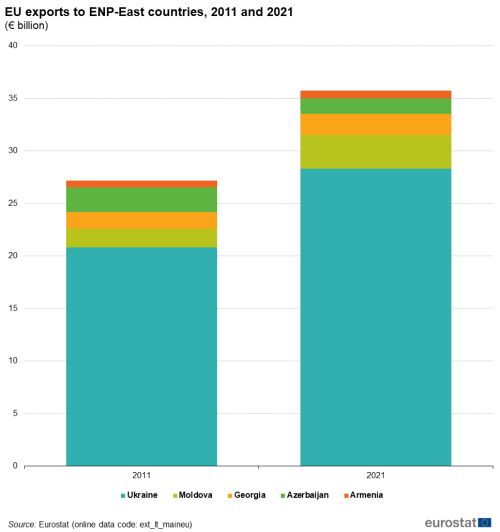
(€ billion)
Source: Eurostat (ext_lt_maineu)
Looking at imports to the EU from ENP-East countries as shown in Figure 5, Ukraine was again the largest trading partner in 2021. Its EU imports were valued at €24.0 billion, up from €14.9 billion in 2011, an average growth rate of 4.9 % a year. Azerbaijan accounted for €13.2 billion of EU imports in 2021, down from €15.3 billion in 2011, an average rate of decline of 1.5 % a year. Goods imported to the EU from Moldova were valued at €806 million in 2011 and €1.8 billion in 2021; the annual growth rate was 8.6 %. Imports from Georgia were valued at €600 million in 2011 and €810 million in 2021; the growth rate averaged 3.1 % a year. EU imports from Armenia were €322 million in 2011 and €456 million in 2021, annual growth being 3.5 %.
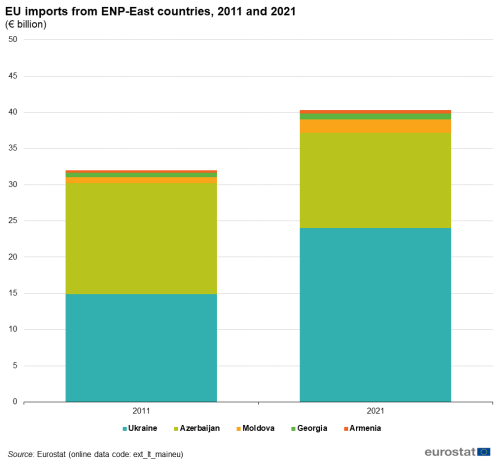
(€ billion)
Source: Eurostat (ext_lt_maineu)
ENP-East trade flows with individual EU Member States
As shown in Figure 6, Poland exported goods valued at €8.6 billion in 2021 to the ENP-East countries, having exported €5.0 billion in 2011. These exports increased during the period at an annual average rate of 5.6 %. Poland was marginally the largest exporter of EU goods to the ENP-East countries in 2021, having been in second place in 2011. In 2021, Germany recorded the second largest exports of goods to the ENP-East countries from among the EU Member States, at €8.3 billion. Its exports had been €9.1 billion in 2011, so they declined at an annual average rate of 0.9 %. Italy exported €2.9 billion worth of goods to the ENP-East countries in 2011 and €3.5 billion in 2021, a growth rate of 1.6 % a year. Hungary exported €2.0 billion in 2011 and €3.3 billion in 2021, so growth was 5.1 % a year. Other significant exporters in 2021 were Lithuania at €2.5 billion and Romania at €2.2 billion. Between them, the remaining 21 EU Member States accounted for €14.3 billion worth of goods exports to the ENP-East countries in 2021.

(€ billion)
Source: Eurostat [https://ec.europa.eu/eurostat/web/international-trade-in-goods/data/database (DS-18995)
Figure 7 shows that Italy was the largest market among the EU Member States for goods imported from the ENP-East countries. In 2021, these were valued at €12.9 billion. Italy’s ENP-East imports had been €11.5 billion in 2011, so that the annual average growth rate was 1.2 %. Oil and gas imports from Azerbaijan accounted for much of this; Italy’s 2020 imports from Azerbaijan had been much lower than in 2021. Poland was the second largest EU import market at €5.8 billion in 2021. The growth rate of its imports from the ENP-East countries from 2011 to 2021 averaged 6.9 % a year – they had been €3.0 billion in 2011. Germany was the third largest importer from the ENP-East in 2021, at €3.9 billion. The 2011 figure was €4.0 billion, so that the annual rate of decline was -0.2 %. Other significant EU importers from the ENP-East in 2021 were the Netherlands, €3.0 billion; Romania, €2.4 billion and Spain, €2.3 billion. Other EU Member States accounted for €15.9 billion of imports from the ENP-East countries in 2021, up from €14.6 billion in 2011.
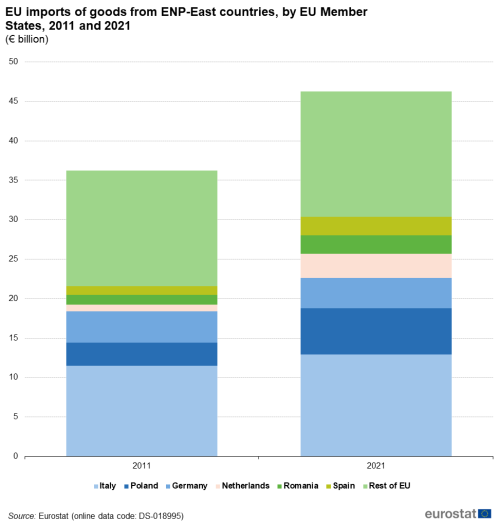
(€ billion)
Source: [https://ec.europa.eu/eurostat/web/international-trade-in-goods/data/database (DS-18995)
Main products traded between the ENP-East countries and the EU
Tables 2a and 2b provide an analysis of trade in goods with the EU by product group for each of the ENP-East countries, using data reported by the EU Member States to Eurostat. The 10 main sections shown follow the standard international trade classification (SITC Rev.4).
The EU’s principal exports to Armenia in 2021 were €225 million worth of machinery and transport equipment (SITC section 7), 30 % of total exports to that country of €758 million. The EU imported manufactured goods (SITC section 6) worth €250 million from Armenia, 55 % of a total of €456 million.
Mineral fuels, lubricants and related materials (SITC section 3), valued at €12 978 million accounted for 99 % of EU imports originating from Azerbaijan in 2021. This section includes coal, oil, natural gas and other petroleum products. Total EU imports from Azerbaijan in 2021 amounted to €13 157 million. EU principal exports to Azerbaijan in 2021 were €610 million of machinery and transport equipment, 42 % of a total of €1 468 million.
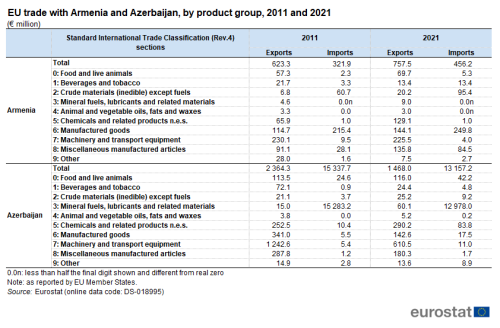
(€ million)
Source: Eurostat [https://ec.europa.eu/eurostat/web/international-trade-in-goods/data/database (DS-18995)
The EU exported €594 million worth of machinery and transport equipment to Georgia in 2021. This was the largest product group, accounting for 29 % of total EU-Georgia exports of €2 045 million. In 2011, EU exports of machinery and transport equipment had also been the largest product group. EU imports in 2021 from Georgia of €374 million of crude materials (inedible) except fuels (SITC section 2) were by far the largest product group, at 46 % of a total of €810 million. Growth in EU imports from Georgia of this product group over 2011-2021 has averaged 6 % a year.
The largest EU exports to Moldova in 2021 were €978 million of machinery and transport equipment, 31 % of a total of €3 187 million. The same product group had also been the largest in 2011. The largest EU imports in 2021 were also from the same product group: €462 million, 25 % of a total of €1 834 million. In 2011, the largest product group imported to the EU had been miscellaneous manufactured articles (SITC section 8).
In Ukraine, by far the largest EU export product in 2021 was machinery and transport equipment, accounting for €10 022 million, 35 % of a total of €28 298 million. In second place was chemicals and related products, (SITC section 5), valued at €5 614 million, 20 % of the total. Manufactured goods provided the largest value of EU imports in 2021, valued at €7 231 million, 30 % of the total. Crude materials (inedible) except fuels (SITC section 2) were the second largest group in 2021, at €5 319 million, 22 % of total imports to the EU, which were €24 030 million. The largest and second largest EU / Ukraine export and import product groups were the same in 2021 as in 2011.

(€ million)
Source: Eurostat [https://ec.europa.eu/eurostat/web/international-trade-in-goods/data/database (DS-18995)
Source data for tables and graphs
Data sources
Traditionally, customs records were the main source of statistical data on international trade. Following the adoption of the Single Market in January 1993, customs formalities between EU Member States were removed, and so a new data collection system, intrastat, was set up for intra-EU trade. In the intrastat system, intra-EU trade data are collected directly from trade operators, which send a monthly declaration to the relevant national statistical administration.
The data for ENP-East countries are supplied by and under the responsibility of the national statistical authorities of each country on a voluntary basis. The data result from an annual data collection cycle that has been established by Eurostat. These statistics are available free-of-charge on Eurostat’s website, together with a range of additional indicators for ENP-East countries covering most socio-economic topics.
Note that although trade flows should ideally mirror each other (in other words be the same from the perspective of the exporter and the importer), there may be considerable differences in the values presented depending upon which party (exporter or importer) is used as the reporting entity. This is the case even when the difference is taken into account between the valuation of exports as free on board (fob) and of imports incorporating cost, insurance and freight (cif). These discrepancies are often referred to as asymmetries and can be seen when bilateral data for two reporting parties are compared. Generally, while international recommendations for reporting trade statistics exist, countries may adopt methodologies that deviate from the recommendations for practical reasons. Consequently, when exports from country A to country B are compared with imports into country B from country A, the figures rarely (if ever) match. More information concerning the causes of asymmetries can be found in the user guide for statistics on the trading of goods.
Tables in this article use the following notation:
| Value in italics | data value is forecast, provisional or estimated and is therefore likely to change; |
| : | not available, confidential or unreliable value; |
| 0.0n | less than half the final digit shown and different from real zero. |
Context
The EU has a common international trade policy, often referred to as the common commercial policy. In other words, the EU acts as a single entity on trade issues, including issues related to the World Trade Organisation (WTO). In these cases, the European Commission negotiates trade agreements and represents the interests of the EU Member States.
The EU seeks to promote the development of free trade as an instrument for stimulating economic growth and enhancing competitiveness. International trade statistics are of prime importance for both public sector (decision makers at international, EU and national levels) and private users, in particular businesses which wish to analyse export market opportunities, as they provide valuable information on developments regarding the exchange of goods between specific geographical areas. These statistics enable the EU to monitor the development of trade ties with its ENP partners, while they are also used by the European Commission to prepare multilateral and bilateral negotiations for common trade policies.
Moldova, together with the Western Balkan countries, is a member of the Central European Free Trade Agreement (CEFTA). CEFTA seeks to promote trade within the Central European region by eliminating tariffs to regional trade and identifying and reducing non-tariff barriers to trade.
The Deep and Comprehensive Free Trade Areas (DCFTA) are linked with the EU Association Agreements negotiated separately with Georgia, Moldova and Ukraine. The DCFTAs allow these countries access to the European Single Market in selected sectors, while granting EU investors in these sectors the same regulatory environment as in the EU.
On 2 July 2021, the European Commission and the EU High Representative for Foreign Affairs and Security Policy presented the Eastern Partnership: a Renewed Agenda for cooperation with the EU’s Eastern partners. The Joint Communication of March 2020 explains how the agenda is based on five long-term objectives, with resilience at its core, in Eastern Partnership policy beyond 2020: Reinforcing Resilience – an Eastern Partnership that delivers for all. The Joint Staff Working Document provides further details - Recovery, resilience and reform: post 2020 Eastern Partnership priorities. The Partnership will be underpinned by an economic and investment plan. The Joint Declaration of the Eastern Partnership Summit ‘Recovery, Resilience and Reform’ of 15 December 2021 reaffirms strong commitment to a strategic, ambitious and forward-looking Eastern Partnership.
In cooperation with its ENP partners, Eurostat has the responsibility ‘to promote and implement the use of European and internationally recognised standards and methodology for the production of statistics necessary for developing and monitoring policy achievements in all policy areas’. Eurostat undertakes the task of coordinating EU efforts to increase the statistical capacity of the ENP countries. Additional information on the policy context of the ENP is provided here.
Direct access to
Books
Factsheets
Leaflets
- Basic figures on the European Neighbourhood Policy — East countries — 2020 edition
- Basic figures on the European Neighbourhood Policy — East countries — 2019 edition
- Basic figures on the European Neighbourhood Policy — East countries — 2018 edition
- Basic figures on the European Neighbourhood Policy — East countries — 2016 edition
- Basic figures on the European Neighbourhood Policy — East countries — 2015 edition
- Basic figures on the European Neighbourhood Policy — East countries — 2014 edition
- International trade for the European Neighbourhood Policy — East countries — 2016 edition
- European Neighbourhood Policy-East countries — Statistics on living conditions — 2015 edition
- European Neighbourhood Policy — East countries — Key economic statistics — 2014 edition
- European Neighbourhood Policy — East countries — Labour market statistics — 2014 edition
- European Neighbourhood Policy — East countries — Youth statistics — 2014 edition
- International trade (enpe_ext)
- European Neighbourhood Policy East Countries Trade in goods by SITC product group (enpe_ext_sitc)
- Trade balance (enpe_ext_bal)
- Share of European Neighbourhood Policy East Countries in European Union 27 trade (enpe_ext_intro)
- International trade in goods - aggregated data (ext_go_agg)
- International trade in goods - long-term indicators (ext_go_lti)
- International trade (ext_go_lti_int)
- International trade of EU, the euro area and the Member States by SITC product group (ext_lt_intertrd)
- EU trade by Member State, partner and product group (ext_go_lti_ext)
- Intra and Extra-EU trade by Member State and by product group (ext_lt_intratrd)
- International trade (ext_go_lti_int)
- International trade in goods - long-term indicators (ext_go_lti)
- Eastern European Neighbourhood Policy countries (ENP-East) (ESMS metadata file — enpe_esms)
- International trade in goods statistics — European Union (ESMS metadata file — ext_go_agg_esms)
- Quality report on European statistics on international trade in goods — 2016-2019 data — 2020 edition
- User guide on European statistics on international trade in goods — 2020 edition
- European External Action Service — European Neighbourhood Policy
- Joint Communication JOIN(2020) 7 final: Eastern Partnership policy beyond 2020: Reinforcing Resilience - an Eastern Partnership that delivers for all (18 March 2020)
- Joint Staff Working Document SWD(2021) 186 final: Recovery, resilience and reform: post 2020 Eastern Partnership priorities (2 July 2021)
- Joint Declaration of the Eastern Partnership Summit: ‘Recovery, Resilience and Reform’ (15 December 2021)
- European Commission — trade policy